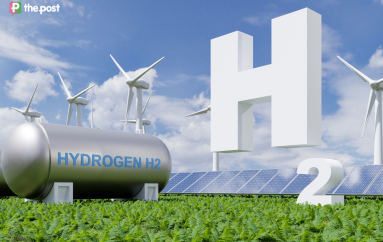How Australian coal can help Germany beat its energy crisis
Our resident demographer finds a pragmatic but very unsexy solution to lowering global emissions.


This column starts in the tiniest of German villages, discusses the business model of Germany, touches on big geopolitical challenges, throws in a photo of Greta Thunberg, mentions Vladimir Putin, begs you to think of the environment as a global system, and makes a plea (with a big fat asterisk) to continue burning Australian coal to slow down global warming.
Buckle up.
In the very West of Germany, only 20km from the Netherlands, lies Luetzerath. It’s an obscure and tiny settlement.
Nobody ever cared about it – until recently that is. Luetzerath just happens to be right next to an open-cut coal mine, a lignite (aka brown coal) mine to be precise.
That’s the worst possible coal to burn. Very polluting.
No surprise that tens of thousands of climate activists are currently very actively blocking the demolition of the few dwellings that make up Luetzerath.
Big and prolonged clashes with police drew massive media attention and attracted the who’s who of the global environmental movement.

Police officers carry Swedish climate activist Greta Thunberg. Photo: Getty
From an environmental point of view, the situation is simple. The dirtiest and least efficient type of coal should stay in the ground. The German Greens and German Labor (SPD) who are part of a governing coalition promised in their election campaigns that coal mines weren’t going to be extended.
For many years everyone in Germany agreed. The nation long ago instigated its Energiewende (energy transition) under Chancellor Angela Merkel (a conservative politician and trained chemist).
This program managed the transition to a low carbon, environmentally sound, reliable, safe (nuclear energy is currently being phased out too), and affordable energy supply. The plan to lower emissions relied heavily on cheap, reliable natural gas flows from Russia.
I think you know where the story takes us now.
Pipelines and pipedreams
Putin started a war in Ukraine. Putin was surprised that Ukrainian forces and NATO opposed him. Putin thought Germany would argue in his favour on the international stage.
After all, the extremely energy-intensive German economy depends on cheap and reliable energy. Germany also just sunk a bucketload of money into a shiny new pipeline to Russia.
Turns out the German parliament was willing to risk the nation’s prosperity to stand up to Putin after all.
Once Putin realised the Germans were serious the shiny new pipeline mysteriously blew up.
Anyhow, the Germans need tons of new energy, and they need it fast. European nations and the US helped to fill the gap, but Germany needs to rethink its energy policy now.
Energy security in Germany is about more than just ensuring that people have cosy homes in winter. It’s about ensuring that the whole business model of Germany continues to work.
Germany produces expensive machinery, materials, chemicals, vehicles, and metal products. Germany’s global competitiveness relies on relatively cheap power.
No wonder then, that Germany considers dirty lignite coal a viable energy source – for now. National prosperity (and for that matter political and societal stability) depends on the nation’s continued prosperity.
The Luetzerath lignite deposits can’t be accessed immediately but only in about three years, so it’s not quick fix anyways.
How should Germany feed its huge demand for reliable baseload power?
Russian gas was the perfect solution but won’t ever come back. Will Germans embrace nuclear energy? Considering the strong anti-nuclear movement in the 1990s my guess is probably not.
What the Germans are doing instead is building LNG terminals to transport gas in from Qatar and anyone willing to sell; and of course, to continue burning coal. Energy security trumps Energiewende .
The continued reliance on coal isn’t just a German issue, it’s a global systemic energy issue.
The International Energy Agency (IEA) reported that the world saw peak coal in 2022. The longitudinal data used in the charts below stops at 2021 at this stage.
We see that global coal usage has roughly stabilised over the last decade despite global energy demand going up.
Peak coal’s timetable
We are consuming more energy globally because of human population growth and increased prosperity.
As I wrote previously, the human population will peak in the next 40 to 60 years. We will continue to increase the living standards of many humans past that mark.
Depending on how fast we decarbonise our energy production, peak energy usage will occur somewhere around that date. The IEA even argued that global energy demand could peak as early as the 2040s.
Coal must be seen as a transitionary source of energy; we need it now but will want to phase it out eventually. The immediate goal must be to get rid of the most polluting form of coal first, which includes the lignite in Luetzerath.
Lignite makes up only about seven per cent of global coal use but a whopping 40 per cent of German coal use. The Germans will only be able to leave their lignite untouched if they get a stable energy supply for a good price and without the political complications.
The plan to use Russia as such a source spectacularly backfired.
Is this where Australia, the world’s fourth-largest coal producer (after China, India, and the US if you wondered…), rides in like a knight in shining armour to save the day?
Annoyingly, the German lignite power plants can’t be easily or cheaply retrofitted to burn bituminous coal.
Planet-friendlier black coal
So, it’s not just a simple matter of sending the Germans our relatively clean bituminous coal and telling them to leave Luetzerath alone.
Sending the Germans our Australian lignite makes no environmental or economic sense for the Germans but might be more digestible politically.
Either way, Germany has liquified natural gas (LNG) terminals and Australia is also the world’s fourth-largest LNG exporter (after Qatar, Malaysia, and the US). Australia could be playing a more important role in German energy affairs.
If we view global energy consumption as the interconnected global system that it is, we should most urgently phase out lignite and keep burning bituminous coal until enough alternative power sources came online to get rid of coal.
In the German case, Australia could help through LNG exports. In the case of China and India (35 per cent of global population), Australian coal can counterintuitively have a positive impact on emissions.
Both nations will see increased energy demands, and they currently burn significant amounts of lignite (in China six per cent of coal usage; in India 13 per cent).
Australia can play a role in helping to phase our lignite power plants by providing bituminous coal as a transitory energy source.
In a previous column, I described the pragmatic Norwegian approach to combating climate change. If, but only if, managed correctly on a global scale Australian coal can be part of a pragmatic but very unsexy solution to lowering global emissions.
Demographer Simon Kuestenmacher is a co-founder of The Demographics Group. His columns, media commentary and public speaking focus on current socio-demographic trends and how these impact Australia. Follow Simon on Twitter or LinkedIn for daily data insights in short format.




